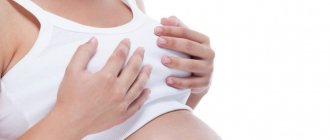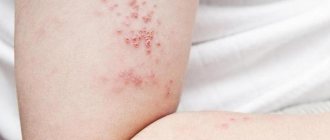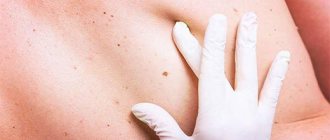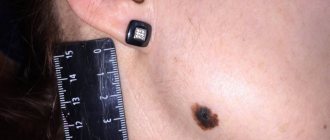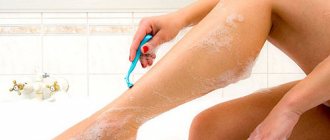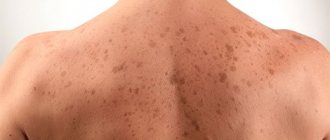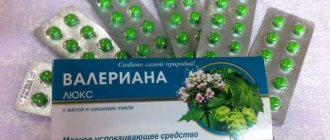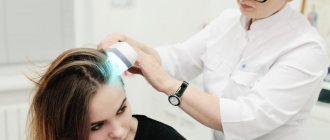Every day the human body is subject to change. They occur inside the body: cells of vital organs are renewed; slowly but surely new neurons are formed in the brain; blood and lymph are cleansed. Changes also occur on the outside: old and rough skin falls away, in place of which layers of fresh epidermis appear.
Also, from time to time, pigmented neoplasms may appear on the skin - nevi, which are more often popularly called simply moles. Some people may have a hundred or even more of them on their body, large and not so large. Others have just a few. Their quantity is not so important as their quality.
What do moles say?
Despite the fact that dermatologists classify most moles as simple cosmetic defects, it is always worth paying close attention to these formations, since often their rate of development, nature, size and color can say a lot about a person’s state of health.
In fact, they are real indicators that inform about the emergence of a serious threat to health and life - skin cancer. For various reasons, one of which is immunodeficiency, the cells of an ordinary and unremarkable mole mutate and transform into melanoma - a malignant skin tumor that quickly progresses and subsequently affects internal organs.
No worries
Many patients, having experienced itching in the area of a mole, read information from unreliable sources and immediately make a terrible diagnosis. In most cases, their fears are not confirmed, since itching itself does not mean anything.
Therefore, it is necessary to answer the question of why a mole itches, what are the reasons for this urge, and find out the possible consequences. And only after making sure that the fears still have a basis, seek qualified help.
Possible causes of itching
- Regularly rubbing the area where the mole is located.
Often, nevi appear in places that are not the most comfortable for them on the surface of the dermis (upper back, armpits, thighs), which are rubbed by clothing made of rough fabric, leather or accessories.
- Lack of vitamins.
Vitamin deficiency brings with it problems that manifest themselves not only inside the body, but also outside. One of its symptoms is itchy skin, which can affect random areas of the body, especially the places where nevi are located. Therefore, if it itches around a mole, then the reason for this may be precisely the lack of vitamins of group A.
- Prolonged exposure to direct sunlight.
Ultraviolet radiation in small doses is useful, but in quantities exceeding the norm, it is harmful to the skin. Moreover, excessive exposure to the sun is dangerous not only due to burns, but also the likelihood of melanoma formation.
- Insect bites.
Quite often, moles itch due to a midge or mosquito bite located near them.
- Imbalance in the hormonal system.
It is more typical for women during pregnancy. Hormonal imbalances are a fairly common phenomenon during this period. One of the signs of such a malfunction is a feeling of itching near the nevi.
- Skin diseases.
Many diseases from the groups of dermatitis or dermatoses manifest themselves through peeling and itching of the skin on which moles may be located.
Why a mole hurts, itches or becomes inflamed - 12 reasons
Moles on the body can sometimes cause some inconvenience. Any discomfort under normal circumstances is temporary, including itching.
However, if the mole itches constantly, this may be due to a reaction to external or internal changes. The causes, alarming symptoms and treatment measures will be discussed in this review.
Causes
Why does a mole usually itch?
When the birthmark does not change its color and size, and other symptoms do not bother the patient, the cause of itching is often associated with a disruption in the functioning of internal organs. Only a doctor can help a patient determine the etiology of a symptom.
Hormonal disbalance
One of the obvious manifestations of hormonal imbalance is increased sweating. Sweat can irritate the birthmark - it itches and sometimes turns red. This phenomenon is most typical for women aged 18-45 (during pregnancy, with irregularities in the menstrual cycle, etc.), sometimes men also suffer from the pathology.
If other causes of the phenomenon are excluded, the patient will have to contact an endocrinologist and begin treatment for hyperhidrosis. In addition, it is recommended to take water procedures more often to wash away sweat, dirt, and sebum from the surface of the body, which irritate moles.
Exposure to ultraviolet rays
Ultraviolet radiation negatively affects birthmarks and significantly increases the likelihood of their degeneration into a malignant form.
If the nevus is a little lighter and itchy, this may indicate a person has been exposed to the sun for a long time. The same applies to artificial tanning.
Periods of continuous stay in a solarium that are safe for skin formations will be:
- horizontal solarium – 7 minutes;
- vertical cabin – 5 minutes.
The best time for sunbathing in summer is 9-11 a.m. in the morning and 5-8 p.m. in the evening.
Allergy
The skin in the area of moles is very sensitive to external influences, therefore, in people suffering from allergies and intolerance to any components, the symptoms of a reaction to an irritant are often localized in this area. To find out whether the unpleasant phenomenon is caused by an allergic reaction, it makes sense to take an antihistamine and then evaluate the result. If there is a decrease in itching, you should make an appointment with an allergist.
Injuries
Injury to a nevus is a common occurrence, especially if the mole “nests” in potentially dangerous areas of the body: in the groin, on the head, in the armpits, on the feet and palms. Benign neoplasms in these places can be damaged due to:
- shaving skin;
- combing hair;
- friction on the surface;
- use of cutting objects in everyday life, etc.
Moles located on the back and abdomen are most likely to be damaged. Trauma to a nevus is almost always accompanied by painful sensations and subsequent severe itching. The skin around the formation may turn red, and peeling is possible.
Attention! Large, protruding birthmarks may bleed after injury. In this case, the injury site should be covered with a sterile bandage and consult a doctor.
When a mole itches, it is often preceded by the adverse effects of external irritants.
Irritating factors
In this case, we are talking mainly about clothing. The group of such factors also includes underwear, bedding and other things with which the birthmark regularly comes into contact.
The cause of itching in this case may be the following:
- inappropriate size of clothing or underwear (small);
- artificial material;
- raw seam;
- low-quality dyes used in the design of graphic images.
To avoid an unpleasant symptom, you should give preference to underwear and clothing made from natural fabrics (linen, cotton) as they allow air to pass through and help the skin to “breathe.”
If the birthmark itches and itches around the mole, you should pay special attention to additional symptoms that may bother the patient. Such an approach is quite justified, since “harmless” scratching can be a sign of a serious process in the body. We are talking about cases when moles degenerate into malignant neoplasms.
Why does a mole itch?
Symptoms of degeneration of a birthmark
Malignization is the process of transition of benign tumors to malignant formations. Within the framework of the topic, this means that the birthmark turns into melanoma. In addition to itching, signs of degeneration include:
- asymmetrical shape - the nevus began to change shape;
- blurred boundaries. Under normal conditions, the mole has a clearly defined outline; if it is blurred, it’s time to sound the alarm;
- pain on palpation and contact with surfaces;
- heterogeneity of color. In the absence of pathologies, the mole has a certain color: pink, light brown, almost black. If the spot itches badly and has dark or light inclusions, you should be wary;
- increased size;
- change in structure. Cracks and growths appeared on the mole;
- altered density;
- loss of hair that grew on the surface of the nevus;
- moisture content of the stain surface;
- bleeding
It doesn’t matter whether the mole has become inflamed as a result of an injury or the process of its degeneration has begun - in any case, therapeutic measures must be taken.
Treatment
If one or more of the above signs are detected, you should immediately contact a dermatologist. If a specialist has confirmed the fact of mechanical damage to the mole, medication and traditional medicine will come to the rescue.
When inflammation of a mole is observed, you can anoint it with ichthyol or erythromycin ointment. A compress made from herbal decoctions, which have an antiseptic and calming effect, has an excellent therapeutic effect.
For these purposes, you can use chamomile, calendula, sage, and celandine. An alternative option is a pharmacy ointment based on calendula.
If the patient experiences a burning sensation and redness of the skin, experts prescribe medications based on Furacilin or Chlorhexidine.
If an injured mole itches, treatment with folk remedies and pharmaceuticals should be carried out on a regular basis.
Attention! When a mole itches and hurts, under no circumstances should it be treated with alcohol.
If you don’t have an antiseptic on hand, vegetable oil is suitable, which not only resists infection, but also softens rough skin.
Features of melanoma therapy
If melanoma develops, the nevus is treated surgically. In this case, only the malignant neoplasm is removed. After excision of the melanoma, its cells are sent for cytological examination. If you contact a specialist in a timely manner, the treatment prognosis is favorable.
What are the dangers of not receiving therapy?
When a birthmark begins to itch, degenerating into a malignant neoplasm, this can cause life-threatening consequences for the patient. Melanoma is the most dangerous form of malignant tumor, since it is prone to rapid metastasis to organs and systems. Lack of treatment can cost the patient his life.
As you can see, a banal symptom manifested in the itching of a birthmark may indicate a number of disparate factors, including: injury, allergic reaction, hormonal imbalance, external irritants.
The most controversial and dangerous process that stimulates the itching of a mole is the degeneration of a benign tumor into a malignant one.
In this and other cases, the patient requires medical assistance, which may consist of the use of medications, folk remedies, or surgical intervention.
The prognosis for treatment if you consult a specialist in a timely manner is favorable: signs of inflammation of the birthmark disappear, and when the mole is removed, a relapse is excluded.
, please select a piece of text and press Ctrl+Enter. We will definitely fix it, and you will get + to karma
(1 5,00 of 5) Loading...
Source: https://papilom-net.ru/rodinka/cheshetsya-rodinki
Location of moles
The appearance of new moles on the body, namely their number and location, is impossible to predict. They can occur symmetrically throughout the body or only in certain places. They can even occur on constantly contacting surfaces (palms and feet, fingers and toes), several pieces per day or just a couple per year.
However, one of the most problematic places where a nevus can appear is the back. In this case, the tumor cannot be studied on its own; you have to either ask friends and relatives for help, or go to a dermatologist.
Also, due to physiological characteristics, it can be quite difficult for a person to reach with his hands some areas of the back, for example, the shoulder blades. Therefore, if a mole on your back itches, it will be difficult to scratch it, which is certainly not a minus, but a plus.
The mole and the skin around it itch and itch
Nevi (moles) are benign formations on the skin. They can have different colors, sizes and shapes. Moles begin to actively appear on the skin during puberty. These formations do not harm a person, but if they begin to change, then you need to consult a doctor.
What to do if a mole itches? How to eliminate unpleasant symptoms? Which doctor should I contact if itching occurs? In this article we will answer all questions in detail.
Provoking factors
Why does a mole itch? Itching of the nevus and the skin around it is provoked by cancerous and non-cancerous factors. In the first case, lack of treatment leads to the development of cancer.
Non-cancerous causes
- Itching due to an allergic reaction to food, fabric, medications or cosmetics.
- Rubbing the mole and the skin around it. This can happen when wearing tight clothes or underwear. In this case, it is better to remove the nevus surgically.
- Insect vinegar.
- Skin diseases. A person is bothered by itching of all moles at once. Unpleasant symptoms disappear after a course of therapy.
The above factors do not require immediate medical attention. For treatment, ointments, gels or tablets are used. The drugs are prescribed by the doctor after he conducts examinations.
Self-medication is extremely dangerous.
Cancerous causes
The process of malignancy is the transformation of a nevus into an oncological tumor. If a mole itches and changes its shape, color and size, this indicates active cell division. A benign tumor can become malignant (melanoma) for the following reasons:
- Hormonal imbalance. This occurs during puberty, menstruation, pregnancy or postmenopause. Corticosteroids and hormonal drugs also have a negative effect on nevi.
- Ultraviolet radiation. Each person has a different safe dose of solar radiation. Excessive exposure to ultraviolet radiation on the epidermis leads to the development of skin cancer. Prolonged exposure to the sun and frequent visits to the solarium have a negative impact on benign formations.
- Injury to the nevus. If a mole itches severely due to damage, you should immediately consult a dermatologist. The injury may cause bleeding. The affected area must be treated with hydrogen peroxide or iodine.
- Massage. It can cause active cell division. Long and strong massage movements can cause inflammation of the epidermis. If the nevus not only itches, but also hurts, then you should consult a doctor.
It is extremely difficult to independently identify the reason why moles itch. Contact a dermatologist or oncologist immediately after detecting suspicious symptoms.
Oncological transformation
In medicine, there are signs that distinguish ordinary moles from malignant formations. They are briefly denoted by the letters ABCDE:
- A - asymmetry. The appearance of melanoma is significantly different from a nevus. Malignant formation does not have a clear shape.
- B - boundaries. Melanoma, unlike moles, has blurred and uneven edges.
- C - color. Benign formations have a certain shade (light and dark brown, black). Melanomas can be of different colors: red, bluish, yellow, pink, orange.
- D—diameter. In most cases, moles are small in size. If it has become several times larger, you should immediately consult a doctor.
- E - changes. If a mole begins to itch, change in color and size, you should be examined by a dermatologist. Such symptoms often indicate the development of skin cancer.
It is not always possible to make a diagnosis based on the appearance of moles. There is a certain group of formations - atypical nevi. They are harmless until they begin to develop.
Conditions under which you should consult a doctor
Increase in mole diameter
There is no need to run to an oncologist if you have a slight itch around a mole. Tingling may occur due to a stressful situation or experience. You should consult a doctor if you have the following symptoms:
- Changes in the color, shape and size of a mole. It may also become bulging.
- Painful sensations. They appear as a result of the development of malignant tumors or damage to the epidermis.
- The skin around the nevus turned red and peeling appeared.
- Bubbles filled with liquid form on the surface of the mole.
- The appearance of light growths on a mole. This symptom is associated with active cell division.
- A person experiences discomfort, a burning sensation in the area of education.
- The surface of the nevus becomes rough and small cracks appear.
It is also necessary to urgently consult a doctor if the red mole itches. This sign indicates inflammation.
Under no circumstances should you scratch a mole or try to eliminate unpleasant symptoms using traditional medicine and medications. This will only make the condition worse. If you have an itchy mole on your stomach, armpits, neck or shoulders, apply a patch to it. Do not touch the formation until you visit a dermatologist.
Why does a removed mole itch?
If the place where the nevus was begins to itch, you should consult a doctor again. There may have been a relapse. This is due to the fact that cryodestruction cannot remove all pigment cells the first time. Such symptoms cannot be ignored. Timely contact with an oncologist or dermatologist will help prevent the development of skin cancer.
Attention! If a mole itches and you want to remove it, you need to have it done by a qualified specialist. You should not undergo this procedure with a cosmetologist.
Diagnostics
To detect skin cancer, the patient must see an oncologist or dermatologist. When you see a doctor, you need to talk in detail about the symptoms and changes that have occurred with the nevus. After this, he will conduct a full examination of the epidermis for the presence of malignant formations.
A dermatologist examines a patient's mole using a dermatoscope
In the early stages of skin cancer development, it is difficult to make a correct diagnosis. The doctor may order tests:
- Biopsy. The oncologist takes a particle of the nevus or removes it completely for examination.
- Histology. To detect cancer cells, the nevus is placed in a special solution and then carefully examined under a microscope. Using histology, the type of formation can be reliably determined.
- Blood test to check for cancer cells. It is carried out only when melanoma is detected. This test helps determine the level of LDH (lactate dehydrogenase).
After receiving the diagnostic results, the doctor will prescribe the most suitable treatment method for you. If moles itch for non-cancerous reasons, then gels, ointments or tablets can be used to eliminate unpleasant symptoms.
Methods for removing problematic nevi
If a mole itches badly for a long time, what should you do? In this case, it is advisable to remove the nevus. The treatment method depends on the type and form of formation.
Ways to remove moles:
- Cryodestruction. Elimination of pigment cells from the skin using liquid nitrogen (temperature – 180 degrees).
- Laser coagulation. This is the most common and effective method of therapy. The formations are removed using a laser beam.
- Electrocoagulation. Pigment cells are removed using small pulses of electrical current.
If a mole on the back itches, grows and is constantly injured, then it must be removed surgically.
Do not ignore the itching of the nevus. Timely consultation with a doctor can prevent the development of skin cancer.
on this topic:
The mole and the skin around it itch and itch Link to main publication
Source: https://VseProZud.ru/zud-tela/drugoe/cheshetsya-i-zudit-rodinka-i-kozha-vokrug-neyo
What does an itchy mole mean?
Many patients are misinformed about the nature and consequences of this itching. They are sure that such itching is deadly and indicates the transformation of a mole into melanoma. However, you need to understand that itching itself in 99 percent of cases only indicates that the skin needs to be cleansed of the coarsened top layer or in vitamins, or for other reasons mentioned above. Nothing bad will happen if you scratch a mole or the area around it with your fingertips.
It is worth noting that itching is indeed one of the symptoms of the formation and progression of skin cancer. But only in combination with other symptoms, which will be discussed below.
- Burning and tingling.
These sensations cannot be confused with itching or anything else. They say that the mole cells increase in number, gradually growing, which is not a positive trend.
- Changing contours.
A dangerous phenomenon is the growth of a mole, in which one part of it becomes darker or lighter, more convex and denser. In this case, the nevus begins to look different, fuzzy edges and strange inclusions form, the shape becomes asymmetrical. If a mole itches and grows, then it is worth checking if there are other negative symptoms.
When is mole removal recommended?
- Location in potentially dangerous areas where a mole can be injured by clothing - this is the area of the bra, back, neck, groin, feet, armpits, palms.
- The formation grows and changes intensively - peeling and asymmetry are observed. All this indicates the possible beginning of degeneration into melanoma.
- The color and texture change, ulcers and cracks appear on the nevus.
- Hair began to fall out completely or partially from the surface of the formation.
- The shape of a mole initially suggests that it is traumatic - it is hanging or convex.
How methods are suggested to remove the formation
- Surgical excision. It is recommended to resort to this method when the process of degeneration of a mole into melanoma is detected. The nevus is excised under anesthesia using a scalpel, and part of the adjacent tissue is captured. After excision, the removed material is sent for histological examination, which will indicate the presence or absence of a tumor.
- Laser removal. The method is effective and virtually does not cause any discomfort. Often, in this way, nevi are removed in potentially dangerous areas where they can be damaged.
- Freezing with liquid nitrogen. If the mole is small in size, you can use this simple one. An effective and safe method. Under the influence of extremely low temperatures, nevus cells die and are destroyed.
- Radio wave method. The method is similar to surgical excision, but nearby tissue is minimally injured. As a result, recovery is much faster.
When professional help is needed
Hair loss from a mole in most cases indicates a malignant transformation of the mole, since only cancer cells, due to their structure, cannot form “channels” for hair.
If a mole festers and bleeds, this indicates that it was severely damaged at some point in time. This is fraught with the formation of melanoma, so in this case a trip to the doctor becomes inevitable.
As mentioned above, the condition itself, when a mole or the area around it itches, is not dangerous. However, if other listed symptoms appear along with itching, then you should not delay visiting a dermatologist, who will make a professional diagnosis and, in extreme cases, give a referral to an oncologist.
Folk remedies
Of course, the problem with moles has existed for a long time. Some traditional medicines are said to help relieve itching. In rare cases, they even lead to the disappearance of the nevus. Let's list some of them:
- Lemon and garlic. The ingredients are obvious. First you need to take a cotton pad and soak it in lemon juice. Next, all that remains is to lubricate the mole with it. After this, you need to repeat the procedure, only this time with garlic juice. This operation should be performed 6 times a day. Traditional medicine says that the itching will go away over time.
- Infusion of celandine. For this recipe you will need the juice of this plant. Don’t get me wrong, but it must be collected on the first day of the new moon, and applied the next day. You can lubricate nevi with infusion several times a day. They say that this recipe can even remove moles. It has not been proven by medicine, but grandmothers say so.
- Vinegar. You should drop this liquid onto the mole for a week. At the same time, it is important to observe moderation. No more than one drop! This must be remembered, otherwise there may be certain negative consequences.
- Hemp oil. For this recipe, you need to take out the butter and mix it with chalk (crushed, of course). The proportions should be one to four. That is, for one spoon of oil there are four spoons of chalk. The resulting mixture must be very carefully rubbed into the nevus.
Read more Kist al Hindi for infertility
Traditional medicine is, of course, good. In addition, the recommended products are usually quite affordable. Often they really turn out to be effective. The word “really” is not used in vain.
IMPORTANT. Whatever one may say, folk techniques are experience that is not confirmed by research, everything is in words. If you experience itching in a mole, it itches or tingles, it is better to seek professional help.
Medical care is faster and more reliable than traditional medicine.
Skin formations that many have become accustomed to since childhood - moles - generally do not bother a person in any way. When a mole itches, this is a reason to carefully examine the nevus and the skin around it and consult a doctor who will find out why the itching occurs and whether it is a symptom of the development of a serious disease. Remember that paying attention to your health is the best prevention of any disease.
What to do if you are only concerned about itching?
If there are no other symptoms besides itching, and there is no time or money to visit a doctor, then you can help yourself at home in the following ways.
- Lotions.
Green tea lotions help a lot, they soothe the skin and soften it. In order to make a lotion, you need to brew natural (preferably whole-leaf) green tea and soak a cotton pad with it, which should then be applied to the problem area of the skin for a quarter of an hour.
- Soft, comfortable clothes.
When a patient visits a dermatologist with a question like: “A mole itches, what should I do?”, then in many cases the first advice he receives from a specialist is to wear loose clothing. Often, itching on the skin appears due to regular friction with uncomfortable clothing or accessories. In some cases, moles in problem areas are advised to be removed to avoid unnecessary hassle and loss of nerves in the future.
- Creams and baby shampoos.
Sometimes moles itch due to skin irritation caused by the aggressive action of shampoo. In this case, you need to temporarily switch to baby shampoo and use a moisturizer until the skin recovers.
General conclusion
The formation of moles is a phenomenon that is not yet fully understood. The exact cause of their appearance is unknown, and it is also impossible to say for sure whether a mole will develop into malignant melanoma.
Often, the fact that this process is taking place is indicated by the feeling of itching of the nevus or the area around it. However, it is pointless to talk about a serious pathology in this case, since itchy skin can be caused by other reasons. It makes sense to talk about melanoma only when there are more than one symptom. In combination with itching, this can be a burning sensation, a change in the contours and growth of the mole, its rotting or bleeding.
Thus, the answer to the question: “A mole itches, what does it mean?” The following thesis may serve as a guide: itching in itself is not dangerous, but if other symptoms are added to it, then you should immediately seek help from a specialist.
